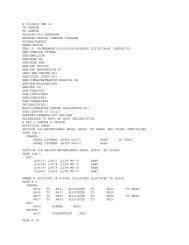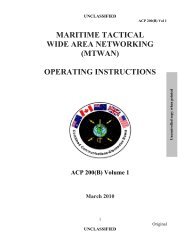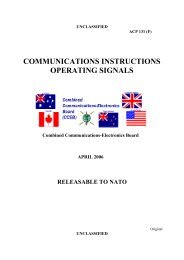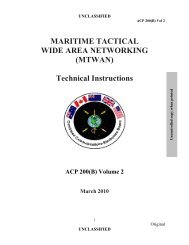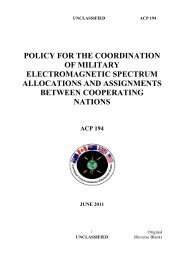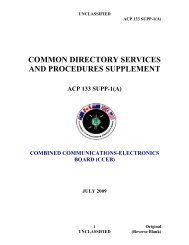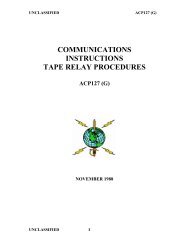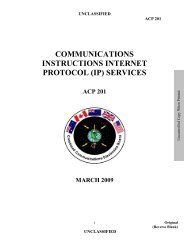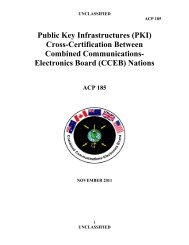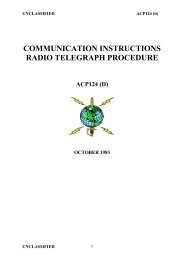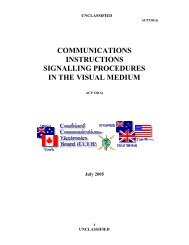ground routing protocol for use with automatic link establishment
ground routing protocol for use with automatic link establishment
ground routing protocol for use with automatic link establishment
You also want an ePaper? Increase the reach of your titles
YUMPU automatically turns print PDFs into web optimized ePapers that Google loves.
UNCLASSIFIED<br />
ACP193<br />
‘190456’. The definition requires that this call dial code be interpreted as ‘UKSIG11’<br />
followed by the direct dial digits ‘90456’.<br />
(g) Use of the ‘,’ (comma) character provides the capability <strong>for</strong> specifying dialling pa<strong>use</strong>s<br />
be<strong>for</strong>e or between direct dial digits when the HF <strong>ground</strong> station is dialling into the <strong>ground</strong><br />
network. Certain old-style telephone exchanges require this functionality. Each comma<br />
represents a two second pa<strong>use</strong>, but a succession of commas can be <strong>use</strong>d in the HF-GRP<br />
message to introduce a longer pa<strong>use</strong>. If pa<strong>use</strong>s are required between dialling digits, which are<br />
derived from a programmed <strong>routing</strong> code, then this in<strong>for</strong>mation must be held locally at the<br />
HF <strong>ground</strong> station since it is not explicitly conveyed in the HF-GRP message.<br />
205. Call Verification<br />
(a) The call verification character is determined from the checksum which results from<br />
the modulo 37 addition of the assigned decimal values of each character in message fields 2,<br />
3 and 4. The mapping of characters to assigned decimal values is defined in Table 2-1 (NB<br />
the ‘,’ (comma) character, if <strong>use</strong>d in field 4, should be assigned a decimal zero value). The<br />
checksum calculation is per<strong>for</strong>med as follows:<br />
N 5<br />
⎞<br />
Call verification checksum = ⎜<br />
⎛ ∑ − valn ⎟MOD37<br />
⎝ n=<br />
5 ⎠<br />
where, n = the position of a character in a HF-GRP message,<br />
n = 1 specifies the first character in a HF-GRP message,<br />
n = N specifies the last character in a HF-GRP message and equals the total<br />
length of the HF-GRP message,<br />
val<br />
n<br />
= assigned decimal value of the character at position n (from Table 2-1),<br />
MOD<br />
37<br />
= remainder after dividing the argument by 37.<br />
(b) The checksum result equates to the assigned decimal value of the call verification<br />
character (in Table 2-1) that is <strong>use</strong>d in the self-verified HF-GRP message. The call<br />
verification character is placed immediately be<strong>for</strong>e field 6 in the message, i.e. when <strong>use</strong>d, the<br />
call verification character position is N − 4 .<br />
(c)<br />
An example of the checksum calculation is shown below.<br />
Content of fields 2, 3 and 4: WP9,4726<br />
Checksum value = (33 + 26 + 9 + 0 + 4 + 7 + 2 + 6) MOD<br />
37<br />
= (87) MOD<br />
37<br />
= 13<br />
Call verification character decimal value = 13<br />
Resulting call verification character from Table 2-1 = ‘C’<br />
HF-GRP message: CCCCWP9,4726CNNNN<br />
2-7<br />
UNCLASSIFIED



